 |
Moonwalker, 1966, Walking chair for disabled. This walking robot for Moon of Surveyor Program has been abandoned and replaced by this little 'Walker' for young disabled. Built by Space General, it was tested at the Medical Center of California, Los Angeles. Pict and text from Science et Vie, Sept 1968. See also : http://cyberneticzoo.com/?p=2616
|
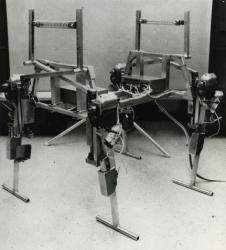 |
Phony Pony, 1968, by Frank and Mc Ghee, University of South Carolina, before existence of microprocessors, but with a computer.
|
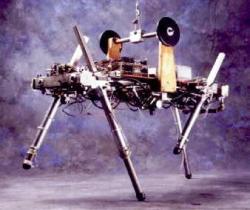 |
Raibert's Quadruped robot, 1985-87. By coupling the legs, the quadruped successfully executed trotting (diagonally paired legs), pacing (lateral pairs), bounding (front pair and rear pair) and several transitions between gaits. From Carl Reeves Thesis, Mc Gill University, Montréal, 2002.
|
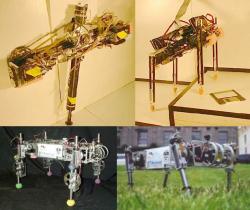 |
ARS Robots for Ambulatory Robotics Laboratory of Pr Martin Buehler created in 1991. It exploited elastic mechanical devices to reduce power consumption. They achieved dynamic walking, bounding, turning and step climbing. From L to R and U to D : ARL's Monopod II 1996, ARL's SCOUT I 1997, ARL's Scout II 1998, ARL's Scout II with passive knees 1999. From Thesis of Carl Reeves, Mc Gill University, Montréal, 2002.
|
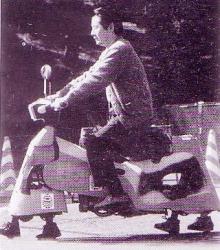 |
Road Runner, 1995, kind of legged moped of Yoshifumi Kaji presented at the Toyota Idea Olympics in Japan. It got a Silver Prize. Nevertheless, it was not at all off-road. Pict from Wheels and Tracks, N° 64 and http://cyberneticzoo.com/?p=5969
|
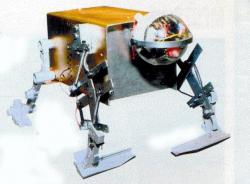 |
Walking Exploration robot of University of Arizona, 1999. Feet instead wheels allowed to move
easier in dust. Legs were moved by mechanic springs which contract and extend under the action of an electric current. A simple concept. Pict from 'Science et Vie', Sept 1999.
|
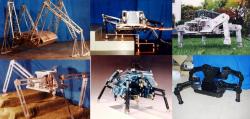 |
Four legged robots of Shigeo Hirose. The Hirose-Fukushima Robotic Laboratory, Tokyo, is one of the most prolific producer of any kind of robots : first snake-like robots (see chap 'Tracked and snakes robots'), walking, wheeled and crawler, planetary, wall climbing, colony robots. Majority of walking robots are 4 legs : from up to down and L to R : Kumo 1976, PV-II 1978-79, Titan III 1981-84, Titan V 1985, Titan VIII, Titan IX. http://www-robot.mes.titech.ac.jp/robot/walking_e.html
|
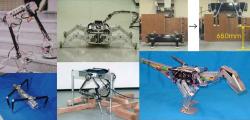 |
Walking robots of Shigeo Hirose, researcher in robots at Tokyo Institute of Technology from1976. Pict : from upper to down and L to R : Yanbo III 2000 with legs and wheels, Hyperion 1999, Walker-Roller 1994 with legs and wheels (see chap Robot Locomotion), Parawalker II 1997, Air Hopper 2002 jumping, Titrius 2000. http://www-robot.mes.titech.ac.jp/robot/walking_e.html
|
 |
Little Dog of Boston Dynamics is used by several Universities to study and learn about legged locomotion. It is able to cross, slowly, rocky terrains. http://www.boston
dynamics.com/robot_littledog.html http://www.youtube.com/watch?v=nUQsRPJ1dYw
|
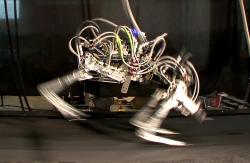 |
Cheetah Fastest Legged Robot of Boston Dymamics that gallops at 28 km/h, inside on a treadmill. http://www.bostondynamics.com/robot_cheetah.html
|